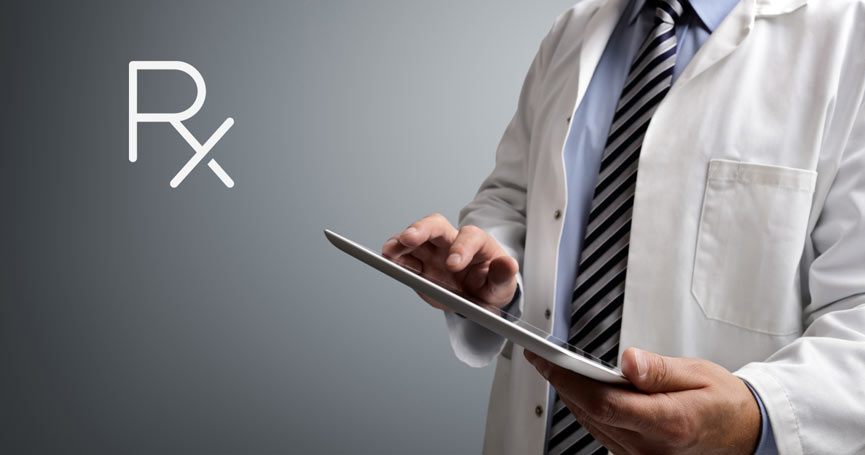
6 Benefits of E-prescribing for Prescribers, Pharmacies and Patients
Electronic prescribing, or e-prescribing, is the electronic transmission and filling of medical prescriptions. E-prescriptions are the hi-tech version of paper, faxed and called-in prescriptions.
E-prescribing is designed to lower the risks associated with traditional prescription writing by enabling healthcare providers to send accurate, understandable prescriptions to pharmacies and by facilitating the sharing of prescription information among providers and pharmacies in order to minimize errors that could harm patients.
90 percent of pharmacies in the U.S. accept e-prescriptions
Doctor’s handwriting is notoriously difficult to read, especially in prescriptions, leaving pharmacists to interpret what they are reading or having to call the provider’s office to get clarification. E-prescribing solves that problem by eliminating the element of handwriting.
Accuracy, efficacy, safety and convenience are making e-prescribing an industry standard. According to the Office of the National Coordinator for Health Information Technology, more than 70 percent of U.S. physicians have transmitted at least one e-prescription.
U.S. Push for E-Prescribing
E-prescribing is part of a U.S. government effort to enhance the safety and quality of the medical prescribing process starting with the Medicare Modernization Act of 2003, which, among other goals, aimed to expedite the adoption of electronic medical records and build a national electronic health information infrastructure.
In 2008, the Medicare Improvements for Patients and Providers Act (MIPPA) was passed to encourage the use of e-prescribing for Medicare recipients, and in 2009 the Health Information Technology for Economic and Clinical Health Act (HITECH) was signed into law to promote the adoption and meaningful use of health information technology.
E-prescribing software can be used independently or be incorporated into electronic health record (EHR) systems that include patient information such as medical history, diagnoses, clinical notes and lab test results. Allowing prescribers to access this information can reduce the potential for medical errors.
At present, 90 percent of pharmacies in the U.S. accept e-prescriptions, and 70 percent of physicians use e-prescribing, according to the Office of the National Coordinator of Health IT.

6 Benefits of E-Prescribing
The benefits and advantages of using e-prescribing to prescribe medications are many. Following are six key ones to consider when starting or increasing an e-prescribing system in your practice.
1. Improved Patient Safety
By far, the most important benefit of e-prescribing is that it can prevent medication errors caused by illegible handwriting, ambiguous nomenclature, oral miscommunication and lapses in knowledge of recommended dosages, drug interactions and adverse drug effects (ADEs).
The Federal Drug Administration (FDA) reports that medication errors cause at least one death a day and injure about 1.3 million people a year in the U.S. These errors occur in the prescribing, repackaging, dispensing, administering and monitoring processes.
The most common causes for the errors are:
- poor communication
- ambiguities in product names
- directions for use
- medical abbreviations or writing
- poor procedures or techniques
- patient misuse because of poor understanding of directions
E-prescribing software improves the medication management process through warning and clinical decision support systems that can check a prescription against patient data such as:
- age
- body weight
- diagnoses (drug-to-condition)
- current medications and potential interactions (drug-to-drug)
- drug allergies (drug-to-allergy)
- potential adverse reactions
- duplicate therapies
- correct dosing.
Many drugs are available in multiple forms and strengths and can be administered by several routes. E-prescribing systems prompt prescribers to choose form, strength, dose, frequency and route through drop-down menus, further reducing the risk of medication errors.
2. More Efficient Pharmacies
E-prescribing makes pharmacies more productive by making the prescription process more efficient.
According to industry estimates, nearly 30 percent of prescriptions require pharmacy callbacks, which reduce the time staff has for other important tasks. An e-prescription, on the other hand, is transmitted from a computer at the prescriber’s office to a computer at the pharmacy, cutting the time pharmacy staff spends interpreting handwriting, calling doctors for clarification, faxing prescriptions back and forth, and entering information manually.
Nearly 30 percent of prescriptions require pharmacy callbacks
E-prescribing software also automates the drug renewal and authorization process, freeing the staff to perform other duties.
3. Convenient for Patients
E-prescribing not only helps pharmacy staff be more efficient and productive, but it is also convenient for patients whose medications are ready for pick up by the time they arrive at the pharmacy.
A patient with a written prescription must travel to the pharmacy, wait in line to drop off the prescription, then wait again in line to pick up the medication—an inconvenience for most people and a problem for patients who are feeling unwell. As a result, written prescriptions often go unfilled.
Patients also benefit from formulary compliance, prior and renewal authorizations, and copay savings facilitated by e-prescribing systems.
4. Increased Adherence
One of the desired outcomes of a more accurate, efficient and convenient prescription process is increased medication compliance or adherence (taking the prescribed medications as directed by the physician).
By making it easier for doctors to prescribe medications and for patients to obtain them, e-prescribing leads to better health results because it removes obstacles that frequently make patients less compliant.
Paper prescriptions not only complicate the process but also have a tendency to get lost, damaged or forgotten. A study by e-prescription software company Surescripts found a 10 percent increase in patients picking up e-prescriptions versus written prescriptions.

5. Reduced Costs
E-prescribing can make medications more affordable for patients—directly by showing prescribers less costly formulary alternatives and indirectly by avoiding ADEs that cost thousands on dollars in emergency room visits.
6. Fewer Adverse Drug Effects
Speaking of adverse drug effects, e-prescribing can eliminate preventable ADEs by reducing the risk of medication errors. A study by the Online Research Journal: Perspectives in Health Information management found that e-prescribing decreased errors from 42.5 per 100 prescriptions to 6.6 per 200 prescriptions.
ADEs are considered preventable when they are caused by medication errors. The Institute of Medicine estimates that 1.5 million preventable ADEs occur in the U.S. each year, and more than 7,000 patient deaths can be linked to poor handwriting and prescription filling errors.
E-prescribing can stop errors before they harm patients. Clinical alert systems built into e-prescribing software warn physicians if a medication they are prescribing has the potential for ADEs due to patient medical history, drug interactions, drug allergies, duplicate therapy and other circumstances.